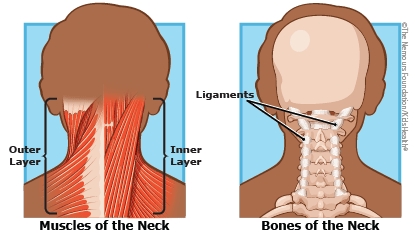Neck Sprain, Strain, or Bruise: How to Care for Your Child
Mild neck injuries usually involve a strain of the muscles or a sprain of the ligaments (rubber band–like connections between the bones). Sometimes the muscles can get bruised too.
In kids, most neck sprains, strains, or bruises (also called contusions) are not serious and get better with rest, cold or warm packs, and pain medicines you can buy without a prescription.


For pain, your child can:
-
Take ibuprofen (Advil®, Motrin®, or a store brand) or acetaminophen (Tylenol® or a store brand), as recommended by your health care provider. Follow the directions on the label for how much they should take and how often.
-
Place a cold pack wrapped in a towel on the area for about 20 minutes several times a day for the first 2–3 days after the injury. Do not put ice directly on the skin.
-
Place a heat pack wrapped in a towel or a heating pad set to medium on the neck for no longer than 20 minutes (being careful not to burn the skin) or have your child take a warm bath or shower. Heat packs can also help if the neck feels stiff.


Your child has:
-
severe pain
-
trouble moving the arms or legs
-
numbness, tingling, or burning in the neck, shoulders, arms, or hands
-
pee or poop accidents

How does a neck sprain, strain, or bruise happen? Most neck injuries are caused by a blow to the head or neck during a fall, sports injury, or auto accident. Whiplash is an injury caused by a sudden jerking of the head that strains muscles and sprains ligaments. Some neck injuries happen over time from repeated stress like sitting at a computer for too long.
How are neck sprains, strains, and bruises treated? Treatment may include a combination of rest, pain medicine, and special exercises to help the neck tissue heal. In some cases, the health care provider may suggest wearing a cervical collar (a soft brace that supports the neck as it heals).